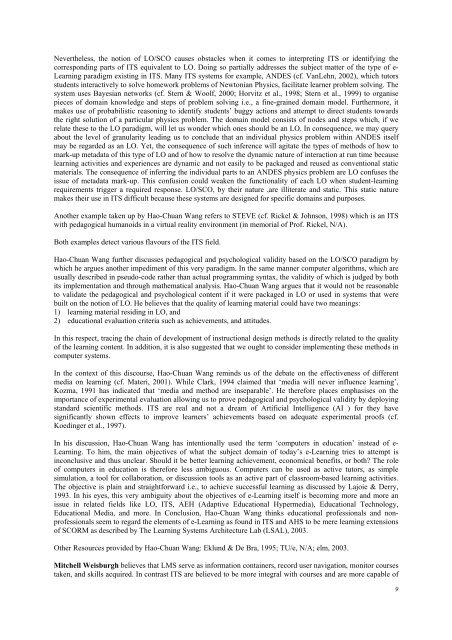Ontologies and the Semantic Web for E-learning - Educational ...
Ontologies and the Semantic Web for E-learning - Educational ...
Ontologies and the Semantic Web for E-learning - Educational ...
Create successful ePaper yourself
Turn your PDF publications into a flip-book with our unique Google optimized e-Paper software.
Never<strong>the</strong>less, <strong>the</strong> notion of LO/SCO causes obstacles when it comes to interpreting ITS or identifying <strong>the</strong><br />
corresponding parts of ITS equivalent to LO. Doing so partially addresses <strong>the</strong> subject matter of <strong>the</strong> type of e-<br />
Learning paradigm existing in ITS. Many ITS systems <strong>for</strong> example, ANDES (cf. VanLehn, 2002), which tutors<br />
students interactively to solve homework problems of Newtonian Physics, facilitate learner problem solving. The<br />
system uses Bayesian networks (cf. Stern & Woolf, 2000; Horvitz et al., 1998; Stern et al., 1999) to organise<br />
pieces of domain knowledge <strong>and</strong> steps of problem solving i.e., a fine-grained domain model. Fur<strong>the</strong>rmore, it<br />
makes use of probabilistic reasoning to identify students’ buggy actions <strong>and</strong> attempt to direct students towards<br />
<strong>the</strong> right solution of a particular physics problem. The domain model consists of nodes <strong>and</strong> steps which, if we<br />
relate <strong>the</strong>se to <strong>the</strong> LO paradigm, will let us wonder which ones should be an LO. In consequence, we may query<br />
about <strong>the</strong> level of granularity leading us to conclude that an individual physics problem within ANDES itself<br />
may be regarded as an LO. Yet, <strong>the</strong> consequence of such inference will agitate <strong>the</strong> types of methods of how to<br />
mark-up metadata of this type of LO <strong>and</strong> of how to resolve <strong>the</strong> dynamic nature of interaction at run time because<br />
<strong>learning</strong> activities <strong>and</strong> experiences are dynamic <strong>and</strong> not easily to be packaged <strong>and</strong> reused as conventional static<br />
materials. The consequence of inferring <strong>the</strong> individual parts to an ANDES physics problem are LO confuses <strong>the</strong><br />
issue of metadata mark-up. This confusion could weaken <strong>the</strong> functionality of each LO when student-<strong>learning</strong><br />
requirements trigger a required response. LO/SCO, by <strong>the</strong>ir nature ,are illiterate <strong>and</strong> static. This static nature<br />
makes <strong>the</strong>ir use in ITS difficult because <strong>the</strong>se systems are designed <strong>for</strong> specific domains <strong>and</strong> purposes.<br />
Ano<strong>the</strong>r example taken up by Hao-Chuan Wang refers to STEVE (cf. Rickel & Johnson, 1998) which is an ITS<br />
with pedagogical humanoids in a virtual reality environment (in memorial of Prof. Rickel, N/A).<br />
Both examples detect various flavours of <strong>the</strong> ITS field.<br />
Hao-Chuan Wang fur<strong>the</strong>r discusses pedagogical <strong>and</strong> psychological validity based on <strong>the</strong> LO/SCO paradigm by<br />
which he argues ano<strong>the</strong>r impediment of this very paradigm. In <strong>the</strong> same manner computer algorithms, which are<br />
usually described in pseudo-code ra<strong>the</strong>r than actual programming syntax, <strong>the</strong> validity of which is judged by both<br />
its implementation <strong>and</strong> through ma<strong>the</strong>matical analysis. Hao-Chuan Wang argues that it would not be reasonable<br />
to validate <strong>the</strong> pedagogical <strong>and</strong> psychological content if it were packaged in LO or used in systems that were<br />
built on <strong>the</strong> notion of LO. He believes that <strong>the</strong> quality of <strong>learning</strong> material could have two meanings:<br />
1) <strong>learning</strong> material residing in LO, <strong>and</strong><br />
2) educational evaluation criteria such as achievements, <strong>and</strong> attitudes.<br />
In this respect, tracing <strong>the</strong> chain of development of instructional design methods is directly related to <strong>the</strong> quality<br />
of <strong>the</strong> <strong>learning</strong> content. In addition, it is also suggested that we ought to consider implementing <strong>the</strong>se methods in<br />
computer systems.<br />
In <strong>the</strong> context of this discourse, Hao-Chuan Wang reminds us of <strong>the</strong> debate on <strong>the</strong> effectiveness of different<br />
media on <strong>learning</strong> (cf. Materi, 2001). While Clark, 1994 claimed that ‘media will never influence <strong>learning</strong>’,<br />
Kozma, 1991 has indicated that ‘media <strong>and</strong> method are inseparable’. He <strong>the</strong>re<strong>for</strong>e places emphasises on <strong>the</strong><br />
importance of experimental evaluation allowing us to prove pedagogical <strong>and</strong> psychological validity by deploying<br />
st<strong>and</strong>ard scientific methods. ITS are real <strong>and</strong> not a dream of Artificial Intelligence (AI ) <strong>for</strong> <strong>the</strong>y have<br />
significantly shown effects to improve learners’ achievements based on adequate experimental proofs (cf.<br />
Koedinger et al., 1997).<br />
In his discussion, Hao-Chuan Wang has intentionally used <strong>the</strong> term ‘computers in education’ instead of e-<br />
Learning. To him, <strong>the</strong> main objectives of what <strong>the</strong> subject domain of today’s e-Learning tries to attempt is<br />
inconclusive <strong>and</strong> thus unclear. Should it be better <strong>learning</strong> achievement, economical benefits, or both? The role<br />
of computers in education is <strong>the</strong>re<strong>for</strong>e less ambiguous. Computers can be used as active tutors, as simple<br />
simulation, a tool <strong>for</strong> collaboration, or discussion tools as an active part of classroom-based <strong>learning</strong> activities.<br />
The objective is plain <strong>and</strong> straight<strong>for</strong>ward i.e., to achieve successful <strong>learning</strong> as discussed by Lajoie & Derry,<br />
1993. In his eyes, this very ambiguity about <strong>the</strong> objectives of e-Learning itself is becoming more <strong>and</strong> more an<br />
issue in related fields like LO, ITS, AEH (Adaptive <strong>Educational</strong> Hypermedia), <strong>Educational</strong> Technology,<br />
<strong>Educational</strong> Media, <strong>and</strong> more. In Conclusion, Hao-Chuan Wang thinks educational professionals <strong>and</strong> nonprofessionals<br />
seem to regard <strong>the</strong> elements of e-Learning as found in ITS <strong>and</strong> AHS to be mere <strong>learning</strong> extensions<br />
of SCORM as described by The Learning Systems Architecture Lab (LSAL), 2003.<br />
O<strong>the</strong>r Resources provided by Hao-Chuan Wang: Eklund & De Bra, 1995; TU/e, N/A; elm, 2003.<br />
Mitchell Weisburgh believes that LMS serve as in<strong>for</strong>mation containers, record user navigation, monitor courses<br />
taken, <strong>and</strong> skills acquired. In contrast ITS are believed to be more integral with courses <strong>and</strong> are more capable of<br />
9
















